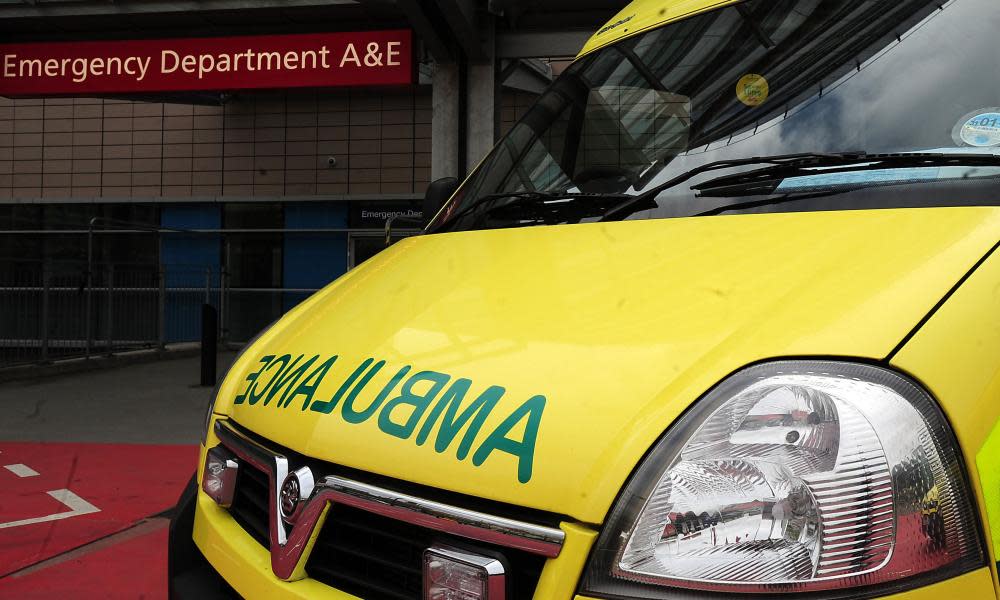Alarm over sharp rise in ambulance patient deaths in England

A sharp rise in the number of patients dying unexpectedly while under the care of NHS ambulance staff has prompted warnings that the service is under “excessive pressure”.
NHS figures for England obtained under freedom of information (FoI) laws show “serious incidents” resulting in the death of a patient more than doubled from 31 in 2012 to 72 in 2016, rising year on year.
One trust noted that a serious incident meant a three-year-old asthma patient had died, and another death was logged as being caused by a delayed response linked to “no resources”. Deaths were also due to missed diagnoses and long delays, with one patient even taken to the wrong hospital.
Serious incidents are logged when the consequences for patients and staff are so significant they warrant investigations. The number of such reports that involved death, low, moderate or serious harm, injury and abuse rose sharply over the five-year period, almost doubling from 194 in 2012 to 376 last year.
“This deeply concerning news must serve as an urgent wake-up call to the government that our overstretched and underfunded ambulance services are in desperate need of more funds,” said Jonathan Ashworth, the shadow health secretary.
“Despite the heroic efforts of our hardworking paramedics, ambulance targets have been missed for well over two years and unprecedented pressures on ambulance services are placing patient safety at serious risk,” he said.
Alan Lofthouse, the national ambulance officer at the trade union Unison, said: “The government’s own figures show that ambulance demand is running at twice the level of funding. This is an unsustainable situation that places excessive pressure on paramedics, who are doing an incredible job treating people in the community and reducing the strain on A&E departments.”
The Association of Ambulance Chief Executives said the incidents amounted to a “tiny” number of patient journeys.
“The increase in serious untoward incidents reported can be attributed to the unabated increased demand for ambulance services and the success of ambulance services encouraging staff to report incidents that can be learned from,” a spokesperson said.
The associate pointed out there had been an average 5.2% rise in calls year on year since 2011-12. However, unexpected deaths increased at a higher rate than calls.
Seven of the 10 trusts responded to the FoI request with data on serious incident reports, but only five had data on the number of unexpected mortalities.
The highest number of deaths was recorded at East Midlands ambulance service, with six mortalities in 2012 and 25 last year, a fivefold increase. The majority were linked to care management and delayed responses.
The proportion of serious incidents at East Midlands declined marginally against call numbers, while unexpected deaths increased proportionally over time. “After investigation, not all incidents identify anything that should have been done differently. However, reporting and investigating means that we use every opportunity to see if we can improve patient care,” a spokesperson for the service said.
The second highest number of deaths was at North East ambulance service, with 22 reported cases in 2016, up from five in 2012.
Alan Gallagher, its head of risk and regulatory services, said: “North East ambulance service is an open and transparent organisation with a culture of learning by mistakes rather than one of blame. We’ve seen an increase in the reporting of incidents and serious incidents over the last few years but we have also seen our overall demand increase ... To be entirely transparent about serious incidents, we record all patient deaths linked to a serious incident, regardless of whether the death was impacted directly by the ambulance service.”
London ambulance service recorded the highest rise in serious incidents, with the service only able to state what harm was caused for the last two years. The number of reported incidents rose from 21 in 2012 to 80 last year. In 2016 there were three deaths, compared with 23 already up to September 2017, an incomplete year. A spokesperson for the service said: “Not all incidents, once investigated, identify anything we should have done differently.”
One death, in May 2017, was because an ambulance was diverted from one hospital to another at the last minute. In the same month another ambulance went to the wrong hospital, resulting in a delay in care. On three instances this year a death was linked to the fact that a London ambulance crew had not recognised ventricular fibrillation, a type of cardiac arrhythmia.
A spokesperson for NHS Improvement, the health service regulator, said: “The safety of patients is a top priority for the NHS. When serious incidents occur we expect NHS providers to investigate and get to the root cause of what happened. The purpose of these patient safety investigations is to establish learning so local, and in some cases national, changes can be made to ensure patients are kept safe and staff are supported to prevent similar incidents occurring.”

 Yahoo News
Yahoo News 
